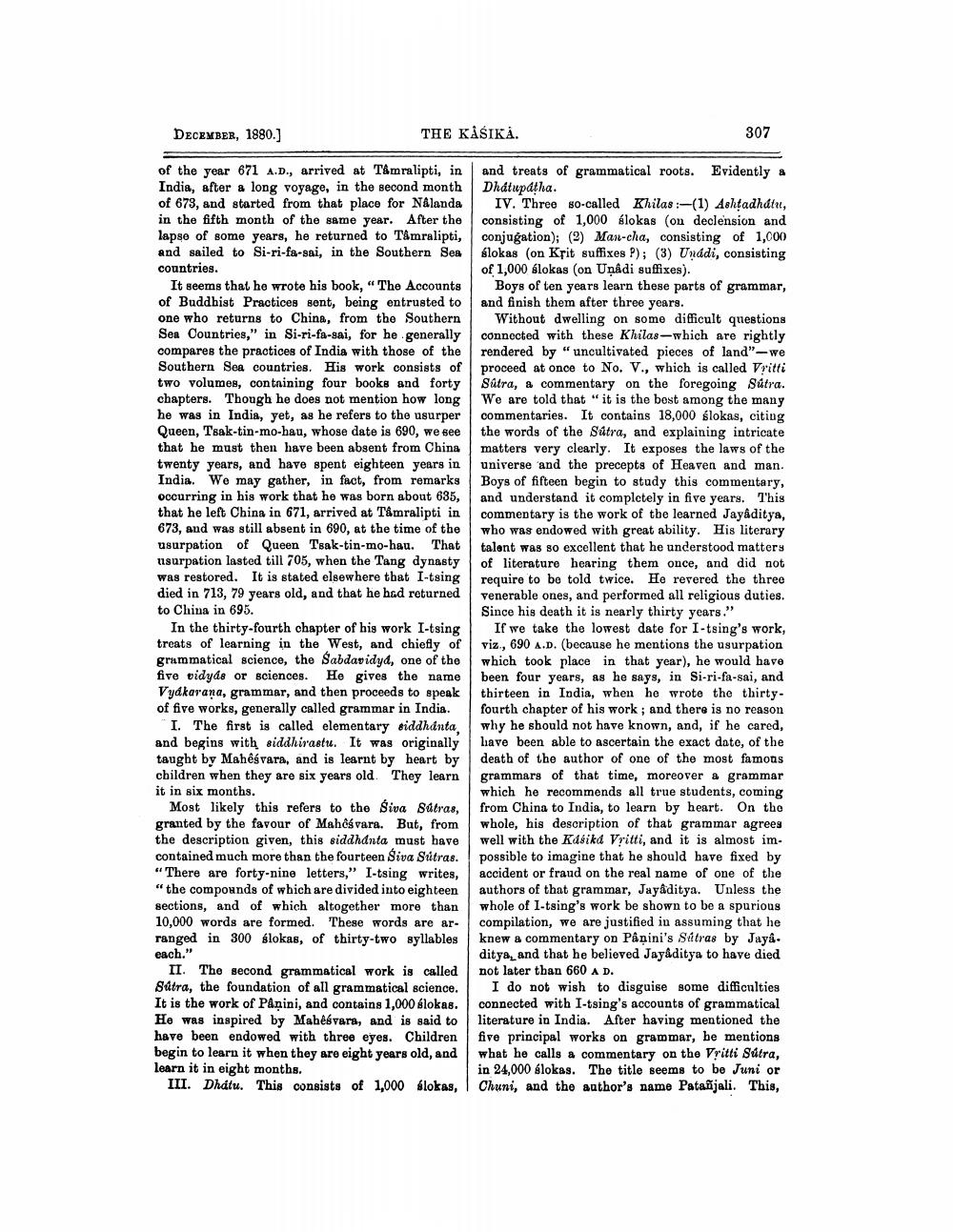________________
DECEMBER, 1880.]
THE KÅSIKA.
307
of the year 671 A.D., arrived at Tamralipti, in India, after a long voyage, in the second month of 673, and started from that place for Nálanda in the fifth month of the same year. After the lapso of some years, he returned to Tamralipti, and sailed to Si-ri-fa-sai, in the Southern Sea countries.
It seems that he wrote his book, "The Accounts of Buddhist Practices sent, being entrusted to one who returns to China, from the Southern Sea Countries," in Si-ri-fa-sai, for he generally compares the practices of India with those of the Southern Sea countries. His work consists of two volumes, containing four books and forty chapters. Though he does not mention how long he was in India, yet, as he refers to the usurper Queen, Tsak-tin-mo-hau, whose date is 690, we see that he must then have been absent from China twenty years, and have spent eighteen years in India. We may gather, in fact, from remarks occurring in his work that he was born about 635, that he left China in 671, arrived at Tåmralipti in 673, and was still absent in 690, at the time of the usurpation of Queen Tsak-tin-mo-hau. That usurpation lasted till 705, when the Tang dynasty was restored. It is stated elsewhere that I-tsing died in 713, 79 years old, and that he had returned to China in 695.
In the thirty-fourth chapter of his work I-tsing treats of learning in the West, and chiefly of grammatical science, the Sabdavidyd, one of the five vidyds or sciences. He gives the name Vydkarana, grammar, and then proceeds to speak of five works, generally called grammar in India.
I. The first is called elementary siddhanta. and begins with siddhirastu. It was originally taught by Mahéávara, and is learnt by heart by children when they are six years old. They learn it in six months.
Most likely this refers to the Siva Sutras, granted by the favour of Maheśvara. But, from the description given, this siddhanta must have contained much more than the fourteen Siva Sútras. "There are forty-nine letters," I-tsing writes, "the compounds of which are divided into eighteen sections, and of which altogether more than 10,000 words are formed. These words are arranged in 300 slokas, of thirty-two syllables
and treats of grammatical roots. Evidently a Dhatupdtha.
IV. Three so-called Khilas :-(1) Ashtadhátr, consisting of 1,000 blokas (on declension and conjugation); (2) Man-cha, consisting of 1.000 slokas (on Ksit suffixes P); (3) Unddi, consisting of 1,000 blokas (on Unådi suffixes).
Boys of ten years learn these parts of grammar, and finish them after three years.
Without dwelling on some difficult questions connected with these Khilas-which are rightly rendered by "uncultivated pieces of land"-we proceed at once to No. V., which is called Vritti Satra, a commentary on the foregoing Sutra. We are told that it is the best among the many commentaries. It contains 18,000 blokas, citing the words of the Sútra, and explaining intricate matters very clearly. It exposes the laws of the universe and the precepts of Heaven and man. Boys of fifteen begin to study this commentary, and understand it completely in five years. This commentary is the work of the learned Jayaditya, who was endowed with great ability. His literary talent was so excellent that he understood matters of literature hearing them once, and did not require to be told twice. He revered the three venerable ones, and performed all religious duties. Since his death it is nearly thirty years."
If we take the lowest date for I-tsing's work, viz., 690 A.D. (because he mentions the usurpation which took place in that year), he would have been four years, as he says, in Si-ri-fa-sai, and thirteen in India, when he wrote the thirtyfourth chapter of his work; and there is no reason why he should not have known, and, if he cared, have been able to ascertain the exact date, of the death of the author of one of the most famous grammars of that time, moreover a grammar which he recommends all true students, coming from China to India, to learn by heart. On the whole, his description of that grammar agrees well with the Kusika Vritti, and it is almost im. possible to imagine that he should have fixed by accident or fraud on the real name of one of the authors of that grammar, Jayaditya. Unless the whole of I-tsing's work be shown to be a spurious compilation, we are justified in assuming that he knew a commentary on Panini's Sútras by Jaya. ditya, and that he believed Jayaditya to have died not later than 660 AD.
I do not wish to disguise some difficulties connected with I-tsing's accounts of grammatical literature in India. After having mentioned the five principal works on grammar, be mentions what he calls a commentary on the Vritti Sútra, in 24,000 blokas. The title seems to be Juni or Chuni, and the author's name Patañjali. This,
each."
II. The second grammatical work is called Sdtra, the foundation of all grammatical science. It is the work of Påņini, and contains 1,000 slokas. He was inspired by Mabesvara, and is said to have been endowed with three eyes. Children begin to learn it when they are eight years old, and learn it in eight months.
III. Dhátu. This consists of 1,000 blokas,




